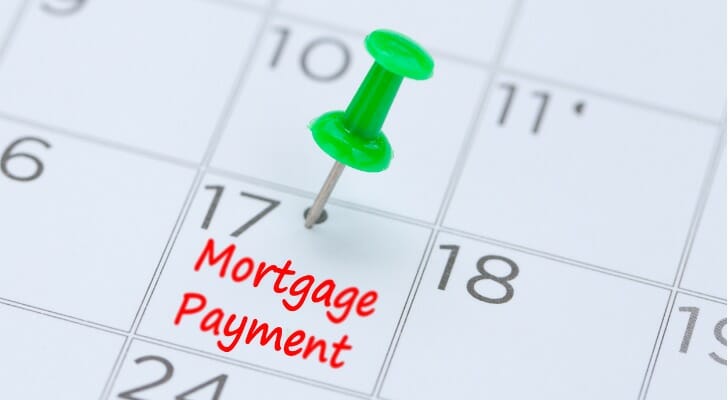A homeowner with enough home equity may be able to use a home equity line of credit to pay off an existing mortgage. That can reduce monthly payments as well as reducing the total interest cost of the loan. This strategy probably only works for homeowners who owe much less than their homes are worth, and comes with a number of risks, including the possibility of higher payments if interest rates rise. It’s always wise to consult a financial advisor before you make any major home financing moves.
The mortgage rate environment is more volatile now than ever. Check out SmartAsset’s mortgage rates table to get a better idea of what the market looks like right now.
HELOC Basics
A home equity line of credit (HELOC) is a loan secured by the equity in the borrower’s home. Unlike a home equity loan, which provides a lump sum, a HELOC works similarly to a credit card. A HELOC borrower has access to a set amount of credit and can choose to borrow as much or as little he or she chooses. The borrower only has to pay back the amount borrowed.
Proceeds from a HELOC can be used for almost any purpose. Many HELOC borrowers use the funds for debt consolidate to pay off higher-rate loans such as credit cards. HELOCs also can pay for renovations, college expenses, investing in rental property or paying off an existing mortgage.
HELOCs have two periods, the draw period and the payback period. During the draw period, typically five to 10 years, the borrower can tap the available credit in the HELOC and can make monthly payments consisting only of the interest. During the payback period, typically five to 15 years, the borrower can’t get any more funds and makes interest and principal payments.
Using a HELOC for Mortgage Payoff
Paying off a mortgage with a HELOC is a method of refinancing a home loan. To do this, the homeowner has to get approved for a HELOC with a credit limit as high as the amount required to pay off the mortgage.
Once approved for the HELOC, the homeowner can draw on the credit limit to pay off the mortgage. Then the homeowner makes the payments to the HELOC rather than to the mortgage. This can boost cash flow thanks to lower payments, while also saving on total interest.
Here’s an example: A homeowner with a home valued at $400,000 has an existing mortgage with an interest rate of 4%, an outstanding balance of $100,000 and 10 years to go. The monthly principal and interest payment on the loan is $1,432. If the homeowner pays off the loan as scheduled, the remaining interest will total $30,040. The homeowner qualifies for a $100,000 HELOC with an interest rate of 3.75%, a five-year draw period and a 15-year payback period. The homeowner draws $100,000 from the HELOC and pays off the mortgage.
The HELOC borrower can make interest-only payments of $313 during the five-year draw period. For the next 15 years, payments increase to $727, including principal. Either way, this frees up a lot of cash each month compared to the $1,432 mortgage payment, at the cost of extending the payoff period by another 10 years. A HELOC mortgage payoff can also save interest. If the borrower pays only interest during the draw period, over the 20-year period of the HELOC interest charges total $30,900. That is $860 more than if the borrower kept paying the existing mortgage.
However, if the borrower made interest-only payments the first year and then began adding enough principle to pay off the HELOC within nine years, total interest comes to $17,977. That’s $12,063 less than the $30,040 in interest remaining on the original mortgage. The loan is paid off in the same 10-year time frame. And the monthly payment the last nine years would be only $1,092, or $340 less than the original mortgage payment.
HELOC Mortgage Payoff Limits
 HELOCs carry some special risks and limitations. To begin with, only homeowners with lots of equity compared to the home’s value can use this strategy. Lenders typically limit the combined total of HELOC and existing mortgage to 80% of the home’s appraised value. That means a homeowner with a $300,000 house and a $125,000 mortgage could likely only get a $115,000 HELOC, as $125,000 plus $115,000 equals $240,000 or 80% of $300,000.
HELOCs carry some special risks and limitations. To begin with, only homeowners with lots of equity compared to the home’s value can use this strategy. Lenders typically limit the combined total of HELOC and existing mortgage to 80% of the home’s appraised value. That means a homeowner with a $300,000 house and a $125,000 mortgage could likely only get a $115,000 HELOC, as $125,000 plus $115,000 equals $240,000 or 80% of $300,000.
For an 80% loan-to-value HELOC, the home needs to be worth two and a half times the balance on the mortgage. Some lenders may have lower or higher loan-to-value benchmarks. For one thing, HELOCs don’t require closing fees, which can total thousands, but may have annual fees. These may be only $50 a year, but add up over the life of the loan.
Also, the amount required to pay off a mortgage may be higher than the outstanding balance on the mortgage. Many lenders charge prepayment penalties for paying off a loan early. A HELOC borrower has to check with the mortgage lender for a payoff quote before implementing this strategy.
Potential for interest rate changes represents another risk. HELOCs are usually adjustable-rate loans pegged to the prime interest rate. If the prime interest rate goes up, the HELOC cost and monthly payment will likely go up too.
It’s also important to remember that homeownership involves property taxes and insurance. Many mortgage payments include escrow amounts to make these payments. A HELOC interest-only or interest-and-principal payment does not include these essential costs.
A HELOC borrower’s home serves as collateral so if a borrower defaults, the lender can foreclose and take possession of the home. But since the mortgage is also secured by the home, replacing it with a HELOC doesn’t necessarily add risk.
Bottom Line
A HELOC can be used to pay off a mortgage and free up significant cash while also reducing total interest charges. However, only a homeowner with a home worth a lot more than the balance on the mortgage can use a HELOC to pay off the mortgage all at once. This strategy also has some additional costs, limits and risks, including the risk of rising interest rates.
Tips on Mortgages
- Using a HELOC to pay off a mortgage calls for careful attention to costs, budgets and other issues – including tax consequences – that are best discussed with an financial advisor before making decisions. Finding a qualified financial advisor doesn’t have to be hard. SmartAsset’s free tool matches you with up to three financial advisors who serve your area, and you can interview your advisor matches at no cost to decide which one is right for you. If you’re ready to find an advisor who can help you achieve your financial goals, get started now.
- Be sure to make full use of our no-cost mortgage calculator as you consider financing options for your residence.
- The mortgage rate environment is more volatile now than ever. Check out SmartAsset’s mortgage rates table to get a better idea of what the market looks like right now.
Photo credit: ©iStock.com/Kameleon007, ©iStock.com/3283197d_273, ©iStock.com/SrdjanPav

